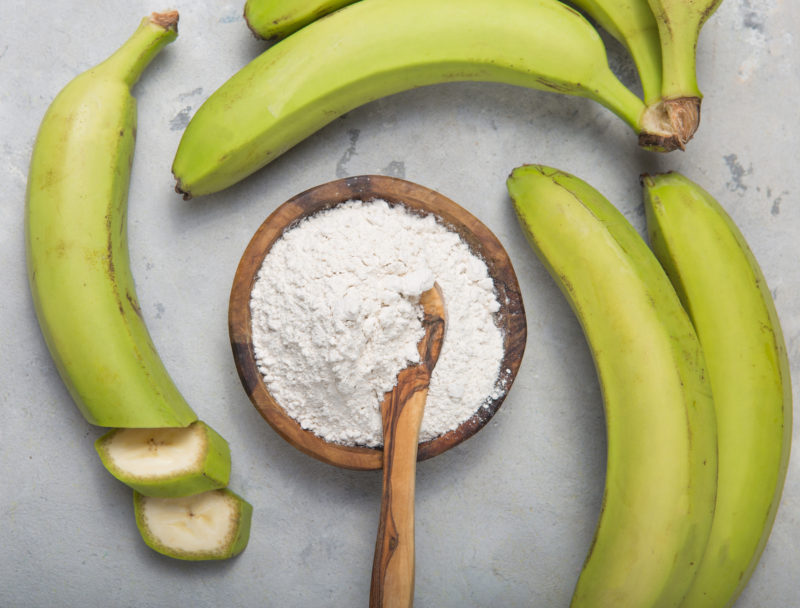Eating fewer starchy foods like potatoes, bread, and rice is conventional wisdom for people trying to lose weight or optimize their glucose levels. That’s because starch is a carbohydrate that consists of numerous glucose units joined by bonds. When we eat certain starches, enzymes break down those bonds into glucose, which impacts our blood sugar levels. Some starches, like those found in potatoes, are higher on the glycemic index, which means they break down more easily, leading to faster uptake of glucose and a potential blood sugar spike.
But not all starch is created equal. Certain types can actually be part of a glycemic-friendly diet.
Resistant starch has a unique molecular makeup—either naturally or as the result of heating and cooling—that helps us digest it differently than other starches, so it doesn’t lead to the same blood sugar spikes after meals. In fact, research shows resistant starch can have several health benefits, including improved insulin sensitivity and increased satiety, so you feel less hungry.
“Since we don’t digest resistant starch, a food’s glucose isn’t rapidly released into the bloodstream, and we don’t see a significant blood sugar spike.”
The effects of resistant starch vary depending on the dose and type. Here are the mechanisms involved and how to reap the benefits by adding this unique ingredient to your own diet.
What is Resistant Starch?
Resistant starch is a type of starch that cannot be broken down by the digestive system (it’s “resistant” to digestion). Unlike other starches, which get digested in the small intestine and broken down into sugar, resistant starch passes through the small intestine unchanged (more on why below). It then ferments in the colon, where it feeds the friendly gut bacteria there, so it can be classified as a form of fiber.
There are five types of resistant starch:
- Type 1 is found in legumes, seeds, and whole grains that cannot be digested because it is bound within the cell walls.
- Type 2 is a naturally occurring resistant starch found in some foods, such as unripe bananas, plantains, raw potatoes, Jerusalem artichokes, and lentils.
- Type 3 is produced when certain starchy foods like rice and potatoes are cooked and then cooled before eating. This type of starch is also called retrograde starch.
- Type 4is an artificial resistant starch created using chemical processes.
- Type 5is a starch that is classically manufactured by heating and cooling certain starches with certain fats, thereby changing their structure and making them resistant to digestion.
Note that the same food can have different types of resistant starch, and the amount can change depending on how food is prepared.
In addition to the metabolic benefits of resistant starch, studies suggest it promotes “good” bacteria in the gut microbiome, helping reduce inflammation in the colon and improve digestive health. Researchers have even looked into whether resistant starch can help reduce the risk of colon cancer.
How Resistant Starch Interacts With Glucose and Insulin
Research shows eating resistant starch can improve insulin sensitivity. One study found that overweight or obese men who ate 15 to 30 grams of resistant cornstarch per day for four weeks experienced significant improvement in insulin sensitivity compared to men who ate non-resistant starch. In fact, the study found, “The magnitude of the increase in [insulin sensitivity] … is similar to that observed with weight loss of ~10% of body weight.” Another study included 10 normal weight and 10 overweight female participants and found that moderate amounts of resistant starch (about 6.5 grams) were associated with lower insulin levels in both groups in the two hours following meals.
Other research shows a similar effect in people with metabolic syndrome. A study published in the journal Diabetic Medicine looked at 20 people with insulin resistance who were either given 40 grams of supplemental resistant starch to eat per day for 12 weeks or a placebo. The resistant starch group saw a 19 percent increase in insulin sensitivity on average, while those who received the placebo saw a 14 percent decrease.
In 44 food logs from Levels members that clearly delineated fresh starch versus cold starch, members saw an average of 10 mg/dL lower glucose response with the cooled starch.
So what accounts for the effects of resistant starch on blood glucose? We can think about this relationship in two ways: first, in the short term after a meal and the long run, when resistant starch is a consistent part of our diet.
When we eat other types of starch, enzymes in our small intestine break down the starch into glucose for energy. But since we don’t digest resistant starch, the food’s glucose isn’t rapidly released into the bloodstream. Therefore we don’t see a significant blood sugar spike. What exactly makes resistant starch resist digestion depends on the type.
- In type 1 resistant starches, for example, the starch is physically inaccessible because it’s inside fibrous cell walls that don’t break down easily.
- Type 2 resistant starches are also naturally occurring and intrinsically resistant because of a molecular structure that’s compact and tightly packed together, limiting the access of digestive enzymes. Many forms of type 2 resistant starch contain higher amylose, which has more complex molecular surfaces that slow enzymatic digestion.
- Type 3 becomes less digestible because of molecular changes that happen as a result of heating and cooling. Inside starch, molecules are ordered in complex structures called granules. When these types of starch get heated in water, the granules swell and deform into a paste. This process is called gelatinization, and the reforming of the starch structure after cooling is called retrogradation. The extent of each of these processes affects the digestibility of the starch granules—the more “deformed” they get, the more resistant they are to digestion.
- Types 4 and 5 are made more resistant through chemical or other processing that changes the molecular structure.
In the long term, eating resistant starch over time improves how the body responds to insulin. Research shows that when resistant starch ferments in the colon, it produces short-chain fatty acids (SCFAs), such as acetate, propionate, and butyrate. Acetate, in particular, is known to inhibit the breakdown of fat tissue, so elevated levels of this short-chain fatty acid lead to a decrease in circulating free fatty acid concentrations. This is important because high circulating free fatty acid concentrations are associated with decreased insulin sensitivity. In other words, lower levels of free fatty acids mean improved insulin sensitivity.
Researchers are also looking at how resistant starch impacts gene expression in fat tissues, which may affect how fat is stored in the body, keeping it out of other areas where it can do harm, such as the muscles, liver, kidneys, pancreas, and the heart.
Ways to Incorporate Resistant Starch into Your Diet
There is no official recommendation for daily intake of resistant starch. In research studies, health benefits have been seen with consumption of 15 to 60 grams per day. Food labels do not list an amount of resistant starch content, so it is not always easy to determine. Still, for context, research shows 100 grams (about 3 and a half ounces) of oatmeal flakes contain around 3.6 grams of resistant starch, while many legumes have between 1 and 5 grams per 100-gram serving.
(Another way to think of resistant starch intake is in the context of fiber intake—recommended to be about 25-38 grams a day—since it is basically a form of fermentable fiber, or fiber that is “eaten” by good bacteria in the colon. Resistant starch appears to produce more healthy butyrate than typical soluble fiber, so it’s a helpful addition to your diet beyond your regular sources of fiber.)
In general, resistant starch appears to be well tolerated at 45 grams per day with few gastrointestinal side effects. Eating more than can lead to uncomfortable symptoms of gas and bloating.
According to a study published in August 2020 in The Journal of Nutrition, adults in the United States consume about 4 grams of resistant starch per day. Research shows Europeans tend to get 3 to 6 grams of resistant starch per day, while people in China get around 15 grams per day. Some countries in Africa consume 20 to 30 grams of resistant starch daily.
Americans could benefit from adding more resistant starch to their diets. Some steps you can take to do this include:
- Eat foods that naturally contain type 2 resistant starch, such as unripe bananas, plantains, legumes, oats, and cashews. Note that this type of resistant starch decreases with heating, so avoid cooking these items unless you plan on cooling them before eating (see below). Instead of cooking oatmeal, for example, make overnight oats by soaking them in milk or non-dairy milk overnight in the fridge. Also, note that once a banana ripens, the starch changes to regular starch.
- Heat and cool certain foods to increase resistant starch. In foods that contain type 2 and type 3 resistant starch (such as rice or potatoes), it’s the heating and subsequent cooling that changes the molecular structure to make the starch more resistant. (Once you’ve heated and cooled, reheating does not lessen resistant starch.)
- Incorporate supplemental resistant starch into your food. One to two teaspoons of supplemental starch, such as potato starch or green banana flour, can be sprinkled into your food. Note that these supplements are made with type 2 resistant starch, which lessens with heat, so add it just before eating, not while cooking. Also, introduce these supplemental starches slowly into your diet to minimize potential GI distress.








